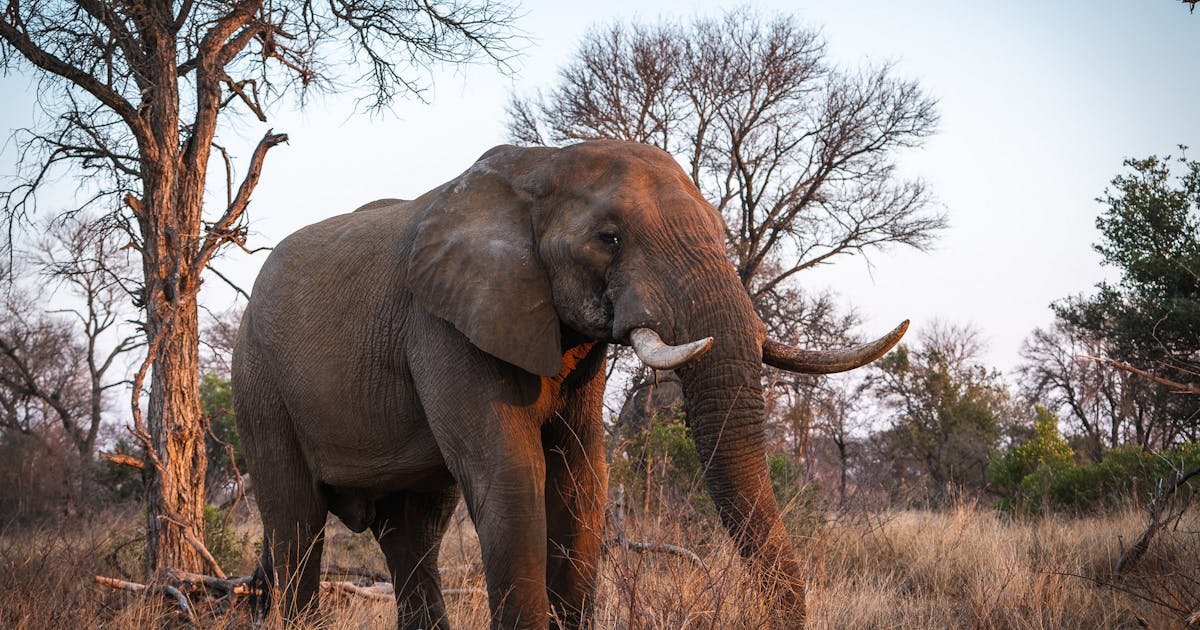BEIRA, Mozambique — Werner Myburgh couldn’t shake the feeling that something was wrong.
On his first trip through the savanna woodlands of Mozambique’s Zinave National Park, he saw almost no animals. “The elephants were gone, the giraffes, lions. Everything was gone,” said Myburgh, who leads the conservation nonprofit Peace Parks Foundation.
Like much of Mozambique, the park had been devastated by civil war. For 16 years, warring factions smothered the landscape, slaughtering animals for bushmeat.
“But something else was really bothering me,” he added. “It was a funny, eerie type of feeling. And then I realized — it was so silent. There were no bird calls or insects or other signs of life. It was like a graveyard.”
A decade after that initial 2014 visit, Myburgh was back in Zinave, sitting by the Save River as a pair of birds with orange beaks glided along the water. “African skimmers,” he said eagerly. “I’ve never seen them here before.”
A deep rumble came from the shore nearby — a pod of surfacing hippos. Vervet monkeys flitted in the trees, sparring for marula fruit. All around, the air was filled with the fluting trill of birds.
 Curious hippos surface from beneath the water. © Peace Parks Foundation
Curious hippos surface from beneath the water. © Peace Parks Foundation
Myburgh’s “silent park” was now roaring with life.
In the past decade, the regional nonprofit Peace Parks has helped the government of Mozambique reintroduce 2,400 individual animals into Zinave — from giraffes and elephants to rhinos and leopards.
But Zinave is one piece of a larger puzzle. For the rewilded species to thrive, they need room to roam. To that end, Peace Parks, in partnership with Conservation International, is working to link five national parks across South Africa, Mozambique and Zimbabwe.
The result is the Great Limpopo, a transboundary park spanning 100,000 square kilometers (38,600 square miles) — an area about the size of Iceland — with protected areas interwoven with community lands. It’s an ambitious plan requiring cooperation from governments to safeguard the land and from communities to adapt to living alongside wildlife that has been absent for decades.
If these challenges can be overcome, the Great Limpopo could be an economic boon for Mozambique, one of the poorest nations in the world.
“Right across the border from Mozambique is South Africa’s Kruger National Park, which has around 2 million visitors a year,” Myburgh said. “Imagine the impact on local communities if we could attract even 10 percent of those visitors to Mozambique’s parks. It starts with bringing back the wildlife.”
?&auto=compress&auto=format&fit=crop?&auto=compress&auto=format&w=800) Lush savanna is returning to Zinave National Park as species are rewilded. © Will McCarry
Lush savanna is returning to Zinave National Park as species are rewilded. © Will McCarry
The Great Limpopo
© Peace Parks Foundation
From the air, Peace Parks and Conservation International’s vision becomes vividly clear.
Flying south from Zinave, a dense canopy breaks over the floodplains of nearby Banhine National Park. Eventually, the landscape transitions into savanna along the edge of Limpopo National Park — a 1 million-hectare (2.5 million-acre) protected area that shares a long and porous border with South Africa’s Kruger National Park.
Vital to the success of the transboundary park is the ability for wildlife to move between Kruger into these other connected landscapes in Mozambique.
Kruger — one of the world’s most celebrated parks and a major conservation success story — is home to hundreds of species of mammals, reptiles and birds, including the “big five”: lion, leopard, African buffalo, elephant and rhino. But Kruger is also a victim of its own success: Many experts believe that it actually has too many elephants for the ecosystem to sustain.
These elephants, which are naturally migratory, have long been unable to move elsewhere: Kruger is fenced along its entire western boundary in South Africa and its eastern border with Mozambique has long been a death trap for wildlife.
 A herd of elephants weaves through the undergrowth. © Peace Parks Foundation
A herd of elephants weaves through the undergrowth. © Peace Parks Foundation
“In the mid to late-2000s, there was a devastating poaching crisis on the Kruger border, with rhino being the most heavily targeted,” said Samuel Davidson-Phillips, a conservation expert at Peace Parks. “Nearly a thousand rhino were being killed for their horns in the park every single year.”
Until 2014, unrestricted hunting was legal in Mozambique. Poachers there could cross the border into Kruger without fear of being arrested back in their home country.
“There are stories of them literally walking across the border between the two countries and laughing at the rangers on the other side, knowing that there’s nothing that could be done,” Davidson-Phillips said.
A ranger navigates the rugged cliffs and dense forest of Limpopo National Park. © Peace Parks Foundation
A quantum leap
At an anti-poaching base deep in the bush of Limpopo National Park, Bruce Missing, a counter-poaching expert with Peace Parks, stood in a tent filled with technical equipment, pointing out landmarks on a wall-sized map.
“This is the map our rangers have been using for the last 20 years to monitor patrols,” he said. “There’s just this one road running through the middle of the park. Imagine that — one road, across an area the size of a small country. It’s amazing habitat for wildlife. But we have to patrol and protect these huge blocks of land where the only way in and out is by air.”
Bruce Missing, a counter-poaching expert, displays snares seized from poachers. © Will McCarry
Missing, who acts as a technical adviser to the government-employed rangers, has implemented sweeping changes — including more organized ranger patrols, tracking poachers with dogs and following scavenger species like vultures to detect potential poaching incidents.
But Limpopo’s vastness still allowed poachers to slip into the park undetected, where they could target not just rhinos but also other threatened species such as elephants for ivory and pangolins for scales, as well as various animals for bushmeat. Additionally, poachers cut down numerous trees within the park, contributing to deforestation. A recent report revealed that millions of tons of illegal timber have been shipped from Mozambique to China over the past few years.
Truly monitoring an area this vast would require a huge upgrade to the ranger’s equipment.
In 2022, with funding from the Global Environment Facility and Allen Institute of Artificial Intelligence, Conservation International deployed an advanced surveillance system known as EarthRanger to Limpopo National Park. The technology offers a real-time display of everything happening at the park at a given moment — including the movements of collared wildlife and the locations of every ranger, vehicle and fence line.
“EarthRanger is a quantum leap forward,” Missing said. “Over the next six months we’re leaving behind this analog system and moving fully over to EarthRanger in a brand-new ops room.”
Earth Ranger enables real-time wildlife habitat monitoring. © Will McCarry
Conservation International also funded the construction of new infrastructure to bring EarthRanger online in Limpopo National Park. Once new cellular towers are built, Missing and his team will be able to monitor around 90 percent of the park at all times.
“Instead of a static map, we will have this fantastic awareness-platform where we can plan, monitor and evaluate our patrols and conservation efforts on a live screen that can also be shared between us and other EarthRanger users like Kruger National Park. That kind of collaboration is absolutely key to our success.”
A large majority of the poaching in the region originates from just outside the gateway to Limpopo, in the dusty village of Massingir. There, crime syndicates have overtaken the town, as kingpins recruit poachers from a population who subsist on less than a dollar a day.
“These aren’t wealthy businessmen going out there for the thrill of the chase,” Missing said. “This is a matter of life and death for one of poorest areas of one of the poorest countries in the world.”
Living with lions
The Great Limpopo and the surrounding areas are home to an estimated 3.5 million people, including communities that rely on land for agriculture, cattle grazing and other livelihoods.
“Many communities living near these national parks are struggling with extreme poverty,”
said Bjorn Stauch, Conservation International’s conservation finance lead. “They can’t possibly focus on conservation when their children have hungry bellies.”
Conservation International and a group of partners, including South Africa’s national park authority, have developed a comprehensive financial plan to bring in funding to support the communities in the areas surrounding Kruger.
“By investing in sustainable, nature-friendly projects — like eco-tourism, regenerative agriculture or wildlife restoration — we are helping to create jobs and provide food security for these families,” Stauch said. “When people have their basic needs met, they are more likely to support conservation efforts because they no longer see nature as something that competes with their survival. Instead, they see it as an asset that can improve their lives.”
A cheetah stalks through the grass. © Peace Parks Foundation
These efforts are helping to restore wildlife to the South African side of the Great Limpopo. And increasingly, those species are making their way across the border into Mozambique.
For the first time in decades, predators such as lions, cheetahs and African wild dogs are back in significant numbers in Limpopo National Park. Their return has spurred new conflict with local communities that rely on cattle for their incomes. Lions can devastate a herd. When that happens, farmers often resort to lacing carcasses with poison for predators to find. This poison not only kills the targeted predators but also scavengers and other wildlife, disrupting the ecosystem.
Whenever lions roam into communities, Missing and his team of rangers bolt into action. He recounted a weeks-long endeavor that involved him doggedly tracking a pair of lions that had been attacking cattle.
“I was out every night, trying to call these lions by playing recordings of injured prey. After a few unsuccessful nights, I got the idea of playing a mating call from a female lion. That did the trick, and we were able to relocate them,” Missing said.
“It’s a lot of pressure — taking the time and care to dart the lions in a way that they won’t be harmed, while also knowing we have a responsibility to the community. Tensions with them definitely ran a little high.”
Davidson-Phillips was quick to clarify.
“Bruce is being modest when he talks about tensions — the community held some of our rangers hostage. I don’t say that to vilify anyone. It’s just a reminder that this is really tough landscape with complicated dynamics. It’s also why the work we’re doing with Conservation International to help communities is so important.”
Herding for Health
A helicopter landed at the edge of the village of Pungwene, scattering clouds of red earth. Even in mid-February, the height of the wet season, the surrounding savanna appeared parched and brittle.
Herding for Health participants from Pungwene. © WILL MCCARRY
Peace Parks staff stepped from the craft and greeted their colleague Délcio Julião, who leads community engagement for the organization.
Pungwene, about 40 kilometers south of Limpopo, is a collection of tents and corrugated-steel shacks — more of an outpost than a permanent settlement. Its populace still lives inside Limpopo most of the time but have agreed to graze their cattle outside the park, where there is more grass and less pressure from predators.
They are participants in a program called Herding for Health, designed and implemented by Conservation International and Peace Parks to ensure livestock herding and conservation can work hand in hand. In Pungwene, participants have signed conservation agreements to adopt grazing practices that restore the savanna. In exchange, they receive veterinary care, water pumps and assistance to protect livestock from predators.
“For me, this is a story about people and nature trying to find a way to coexist in a place where both are very vulnerable,” said Julia Levin, who leads Conservation South Africa (the local affiliate of Conservation International). “Herding for Health helps make this possible by using the knowledge and resources that communities already have to improve both conservation and livelihoods.”
Julião led the way toward a large boma — a circular corral, brimming with baying cattle. Used by Indigenous people across Africa for centuries, bomas were traditionally constructed from wooden poles and thorny branches. This one was built from metal and layered with thick canvas, sturdy enough to keep the herd confined but light enough to be moved regularly.
 The boma ensures cattle are protected from predators. © Peace Parks Foundation
The boma ensures cattle are protected from predators. © Peace Parks Foundation
At night, when predators are most active, herders lead the cattle back inside the boma. “Lions are opportunistic hunters that seek out easy prey, separated from the herd,” Julião said. “This means that livestock bunched together behind steel walls at the edge of a human settlement makes for an incredibly unappealing target.”
Since Peace Parks and Conservation International began implementing Herding for Health in 2019, Pungwene has had no cattle killed by predators. But the boma has another critical purpose: restoring the grasslands.
Julião hurried to assist the community members in releasing the cattle from the boma for the day. As the gates swung open, the cattle instinctively separated into smaller groups, and were greeted by professional herders who had the dual responsibility of protecting the cattle from roaming predators and ensuring they did not overgraze the land.
Once the cattle were cleared, a group of women entered the enclosure, each carrying bags of seeds collected from native grasses. They sprinkled the seeds over loose soil, churned by the movement of hooves and enriched with manure. In time, this would provide vital nutrients for the seeds to germinate. As the grasses grew, they would become habitat for wildlife, and their extensive root systems would anchor the soil, sequestering climate-warming carbon deep into the ground.
In seven days, the boma would be relocated, and the process would be repeated — a continuous cycle to keep the grassland healthy.
Return of the rhino
In 2022, an armed convoy moved across the land carrying precious cargo: 19 white rhino.
Rhino had been locally extinct in Mozambique for decades due to poaching. Backed by a well-organized anti-poaching team and EarthRanger, Peace Parks and park officials had decided it was time for them to come home.
Peace Parks’ CEO Werner Myburgh helps translocate a rhino. © Peace Parks Foundation
The crossing was the longest overland translocation of rhino ever attempted — a 1,000-mile voyage from a private game reserve owned by a South African mining company to Zinave National Park. Accompanying the rhinos were veterinarians, poised to help if needed, while guards vigilantly monitored the route. The convoy faced the possibility of ambush by poachers.
“We were so worried that the rhinos would be overcome by stress on the journey, but every single one made it safely to the park,” said António Abacar, Zinave’s park warden. “It was a big deal for our country. The president of Mozambique attended the release and everyone burst into applause when the gate opened and the rhinos left the holding pen.”
Two more relocations brought the total number of rhino in the park up to 37, including its first black rhinos — a more solitary, aggressive species that is notoriously difficult to dart and transport. Here, they joined dozens of other species that had been successfully rewilded: warthogs, trailed by spiky-haired piglets; wildebeest galloping alongside newborn calves; and antelope around every corner, from the shaggy waterbuck to the striped and chestnut nyala.
Elephants, too, had been returned to this place where they had been absent for so long. In total, 250 elephants now roamed the park, many of them relocated from areas where they had been in danger of poaching or in conflict with communities.
“When we brought back the elephant, that’s when we really started to see a change in the ecosystem,” said Myburgh, Peace Park’s CEO. “Elephants are architects of the land. They push down trees, they open up thickets of invasive plants, convert bush into grassland for grazers and create habitats for a variety of other species.”
The decades without elephants and rhino had changed Zinave — woodlands had expanded, and grasslands grew tall, fueling frequent, intense fire seasons. But now, a balance is re-emerging: Ribbons of grassy savanna weave into marshy lowlands inhabited by hippos and crocodiles, through ironwood thickets scattered with 1,000-year-old baobabs, and along winding rivers dominated by green-barked fever trees.
But one critical species was still missing.
“I always said that Zinave would not be whole until the lion returned,” Abacar said.
In August 2021, Justin Landrey, who helps oversee the park’s infrastructure, went out to check one of the camera traps at the far edge of reserve. It had been destroyed.
Luckily, the team was able to plug in the camera’s tattered remains. There, captured on film, was the culprit — a male lion, stalking through the forest.
A lion caught on a camera trap — an unexpected thrill for Zinave’s park officials. © Peace Parks Foundation
Everyone was ecstatic. It was the first lion in Zinave in over 40 years.
“And he was just the first,” Myburgh said. “It wasn’t long before a female and a juvenile were also recorded. And then just last year we had three adult males also recorded.”
No one quite knows how the lions found their way to Zinave, but it was a triumph for the Great Limpopo — to imagine the lions roaming through Limpopo, into the floodplains of nearby Banhine National Park, and all the way to the Save River in Zinave, taking routes through the connected landscapes that Peace Parks and Conservation International had worked hand in hand with communities to protect.
The lions also made Zinave Mozambique’s first “big five” park, setting the stage for the next phase of Peace Park’s plan: building a tourism industry in Mozambique, one led by local communities. But for now, Zinave is still a hidden gem.
“Today, Zinave is a different kind of silent park,” said Landrey. “After all, it may be the only ‘big five’ reserve in the world where you can be the only tourist.”
Seven rhinos have been born in Zinave since their return to the park. © Peace Parks Foundation
Further reading:
Will McCarry is the content director at Conservation International. Want to read more stories like this? Sign up for email updates. Also, please consider supporting our critical work.




?&auto=compress&auto=format&fit=crop?&auto=compress&auto=format&w=800)
?&auto=compress&auto=format&fit=crop?&auto=compress&auto=format&w=800)

?&auto=compress&auto=format&fit=crop?&auto=compress&auto=format&w=800)






